Taipei is teeming with leisurely half day hikes — but it’s still hard to find a route that’s close to an MRT and not too built up nor packed on the weekends. I’m also not a fan of the concrete or stone steps that line many of the paths close to town.
I only wanted to be walking for a few hours, and an Internet search narrowed my options down to one attractive trek: the Kangle Mountain (康樂山) and Mingju Mountain (明舉山) trails in eastern Neihu District.
So when my friend invited me on an afternoon hike to the popular Jiannan Mountain (劍南山), I immediately suggested we try Kangle and Mingju instead.
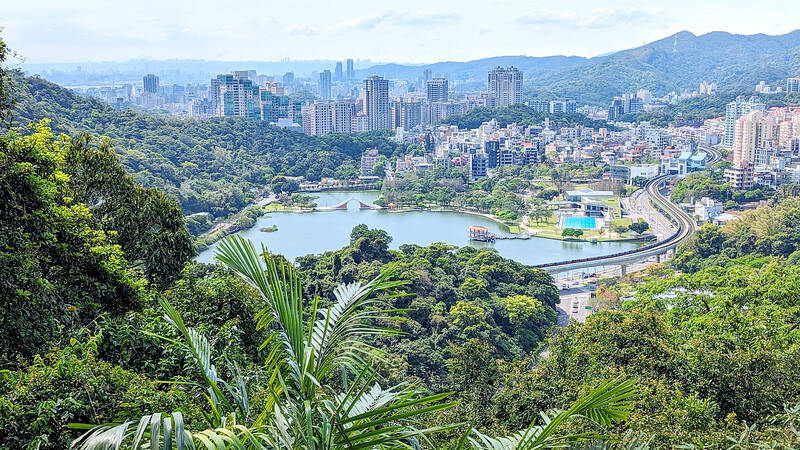
Photo: Han Cheung, Taipei Times
Both trails can be done in an hour or less if you’re a decent hiker, with Mingju being more challenging and wilder. There’s a break to the road between the two, so you can choose to just do one of them if you wish. The eastern end of the Mingju Trail leads to the Wufenpi Wetlands (五分埤), making for a pleasant riverside walk to Donghu MRT station.
For an extra challenge, tack on Bailusi Mountain (白鷺鷥山) south of Dahu Park to the beginning of the trek — it’s a twisting but brisk walk that concludes near the trailhead to Kangle Mountain.
EASY WALK WITH A VIEW
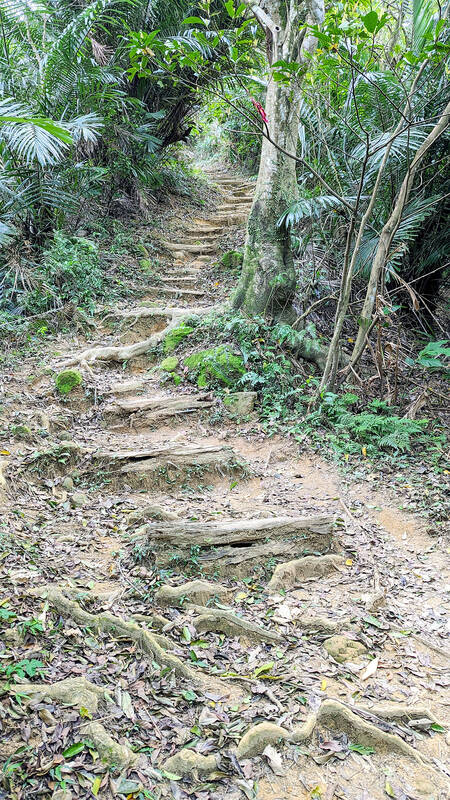
Photo: Han Cheung, Taipei Times
The trailhead to Kangle Mountain is just a 10-minute walk from Dahu Park MRT station, but it’s easy to miss, hidden between a blue building and a white building on Chenggong Road (成功路). The structures are located across the street from the Huangshigong Temple (黃石公廟).
The first 10 minutes or so are concrete steps, but they end quickly at the ruins of a temple and an impressive olive tree, which is said to be the largest in the city. There’s a sign apologizing for the rest of the trail being unpaved due to it being private land, and to watch your step. Well, that’s why I’m here.
It’s a pretty easy ascent to the summit (128m) on mostly dirt paths with wooden slope supports, and there’s an spectacular view of Dahu Park and the mountains beyond along the way. Retrace your steps after reaching the summit and follow the sign that says “Antai St. Woodblock Printing Station.” I could not find this station, but it’s the right way to go.
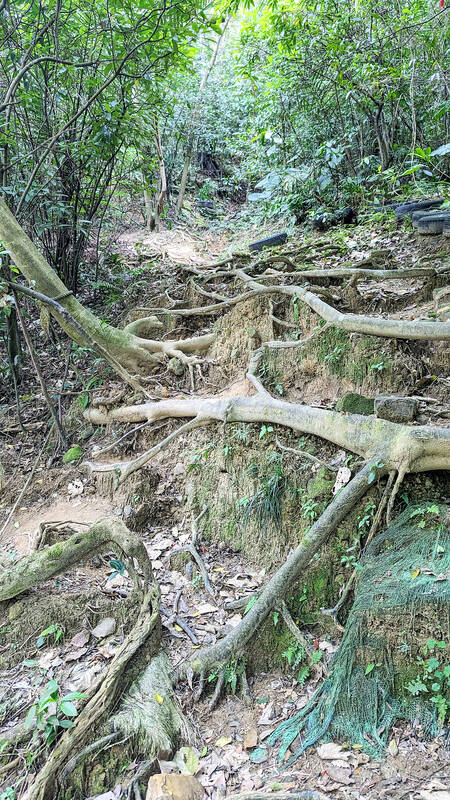
Photo: Han Cheung, Taipei Times
The trail ends at the Shuiyuandi Fude Temple (水源地福德宮) where there’s an old, small stone Earth God shrine inside the ornate main shrine. There’s a few women here clearing the land and planting crops, and they’re happy to chat.
Turn right at the paved road and hang another right at another Earth God shrine onto Antai Street (安泰街). There was once a coal mine here, but I could not find any trace of it. The trailhead to Mingju Mountain is shortly down the street.
WILDER AND STEEPER
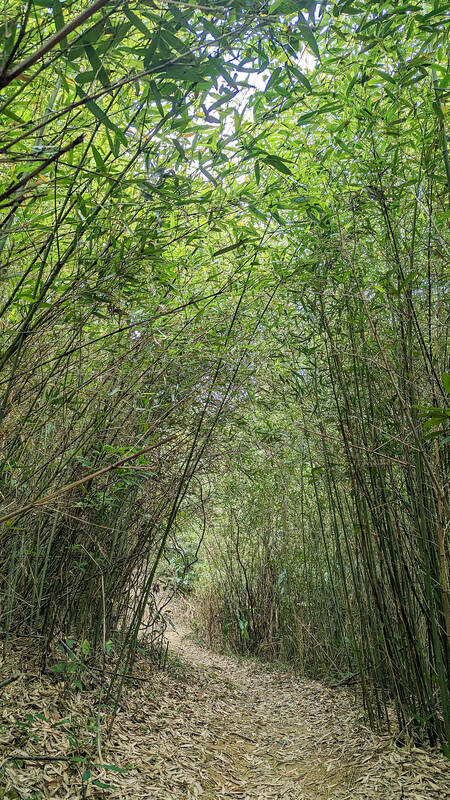
Photo: Han Cheung, Taipei Times
Brace yourself for the first section of this trail, its a steep climb for a decent stretch over twisting tree roots. There are no steps on this up-and-down path of about 1.4km, which can get a bit steep at certain points. Those who survived the first bit shouldn’t have much trouble, however.
The path winds down to the Neigou Ecological Center, but instead take the stone stairs on the left to a stone precipice with some ornate natural rock art created by the elements.
There are also several signs explaining the history of the area. The mountain’s namesake Chiu Ming-ju (邱明舉) was one of three landowners who farmed the area during the Qing Dynasty. Neither three produced heirs, so in 1881 they chose Chiu Chin-fa (邱進發) to take over the properties. In 1934, Chiu Chin-fa’s descendants built the Mountain Lord Shrine (山主祠) to pay tribute to the three benefactors. The shrine was prone to flooding, so they moved it to it’s current location behind the ecological center in 1974. In 1994, Chiu Chi-jen (邱繼仁) began building the Mingju Mountain Trail for leisure purposes, spending half a year manually clearing the hills and
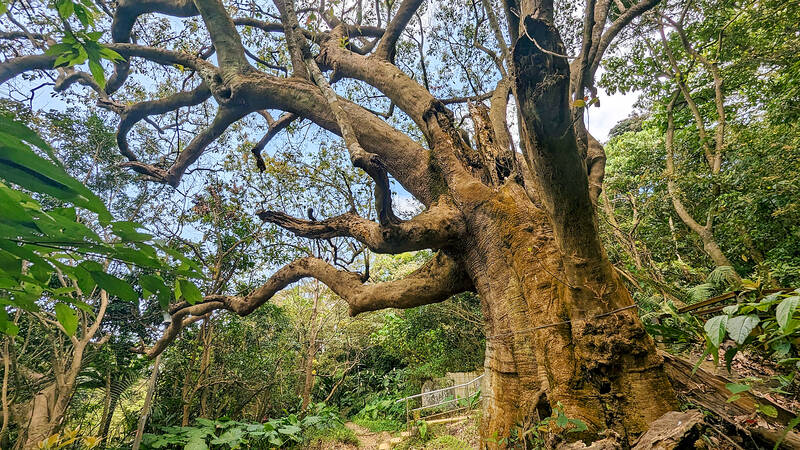
Photo: Han Cheung, Taipei Times
From the ecological center, hikers can walk, YouBike or take a bus to Donghu MRT station. Those who want to keep hiking can head to the Neigou Mountain Trail (內溝山), which continues on toward New Taipei City’s Sijhih District (汐止).
Walkers and bikers can head south on Kangle Street to reach the Wufenpi Wetlands and keep following the meandering riverside paths to Donghu Road (東湖路), which leads straight to the station.
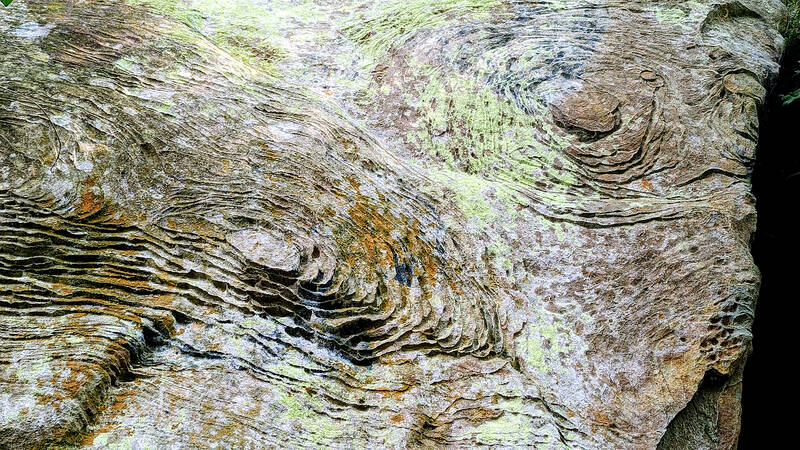
Photo: Han Cheung, Taipei Times
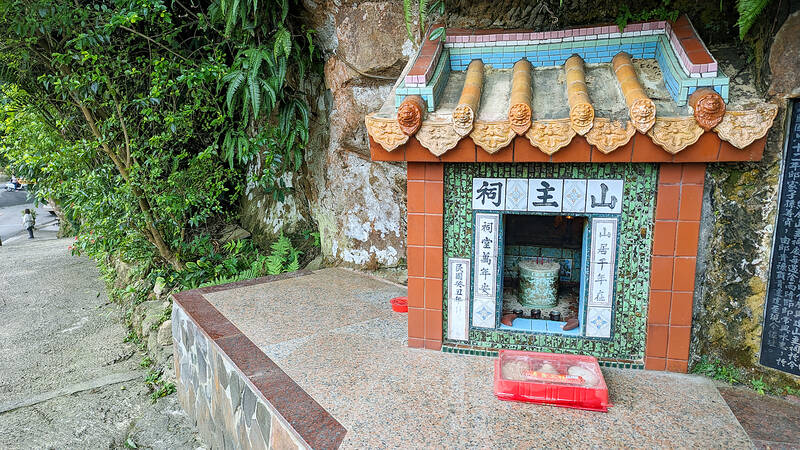
Photo: Han Cheung, Taipei Times
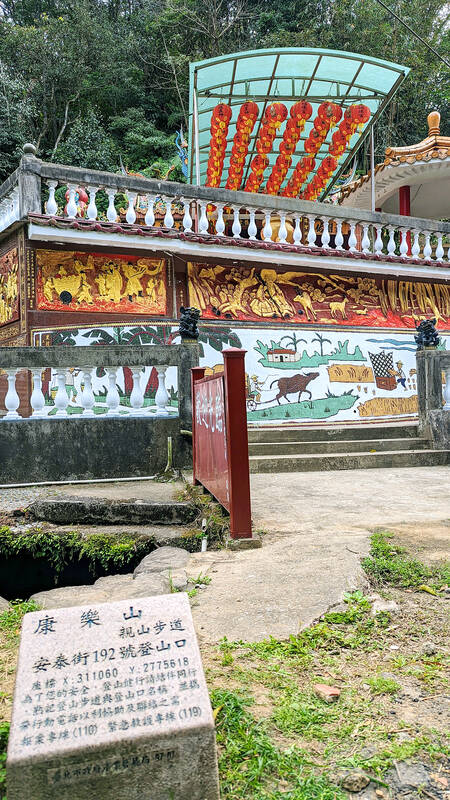
Photo: Han Cheung, Taipei Times

May 11 to May 18 The original Taichung Railway Station was long thought to have been completely razed. Opening on May 15, 1905, the one-story wooden structure soon outgrew its purpose and was replaced in 1917 by a grandiose, Western-style station. During construction on the third-generation station in 2017, workers discovered the service pit for the original station’s locomotive depot. A year later, a small wooden building on site was determined by historians to be the first stationmaster’s office, built around 1908. With these findings, the Taichung Railway Station Cultural Park now boasts that it has

The latest Formosa poll released at the end of last month shows confidence in President William Lai (賴清德) plunged 8.1 percent, while satisfaction with the Lai administration fared worse with a drop of 8.5 percent. Those lacking confidence in Lai jumped by 6 percent and dissatisfaction in his administration spiked up 6.7 percent. Confidence in Lai is still strong at 48.6 percent, compared to 43 percent lacking confidence — but this is his worst result overall since he took office. For the first time, dissatisfaction with his administration surpassed satisfaction, 47.3 to 47.1 percent. Though statistically a tie, for most

Six weeks before I embarked on a research mission in Kyoto, I was sitting alone at a bar counter in Melbourne. Next to me, a woman was bragging loudly to a friend: She, too, was heading to Kyoto, I quickly discerned. Except her trip was in four months. And she’d just pulled an all-nighter booking restaurant reservations. As I snooped on the conversation, I broke out in a sweat, panicking because I’d yet to secure a single table. Then I remembered: Eating well in Japan is absolutely not something to lose sleep over. It’s true that the best-known institutions book up faster
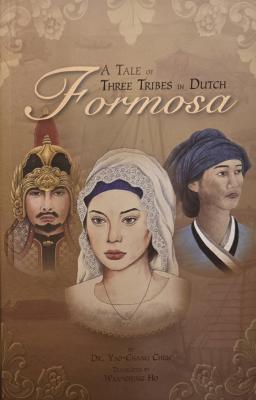
The excellent historical novel by Chen Yao-Cheng (陳耀昌) is a gripping tale of Taiwan in the 17th century, called Formosa at the time, told from the perspective of characters representing the three major ethnic groups (the “tribes” mentioned in the title): the indigenous community, the Dutch and the Chinese. Another element that makes this book stand out is the female perspective, as two of the main protagonists are Maria, the daughter of the Dutch missionary Hambroeck, and Uma, an Aboriginal woman with a strong character. The main Chinese character is Chen Ze, a man in charge of a merchant ship